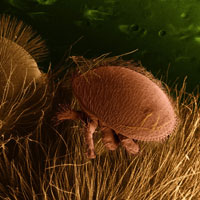 In a previous article I’ve written concerning varroa mites I mentioned the three general methods of treatment. The chemical method was first which, personally, I try to avoid since chemicals have so many disadvantages. I also wrote of a few things you can do mechanically like installing screen bottom boards, replacing old comb, and removing drone comb. Here are a couple of alternative treatment methods that are effective in fighting our tiny adversary, the varroa mite.
In a previous article I’ve written concerning varroa mites I mentioned the three general methods of treatment. The chemical method was first which, personally, I try to avoid since chemicals have so many disadvantages. I also wrote of a few things you can do mechanically like installing screen bottom boards, replacing old comb, and removing drone comb. Here are a couple of alternative treatment methods that are effective in fighting our tiny adversary, the varroa mite.
An easy, popular method of treatment is a sugar dust. You’ll need a screened bottom board, a sticky board, approx. 1 cup of powdered sugar per hive, and a flour sifter. Place the screened bottom board on the hive and insert the sticky board in the slot under the screen. Using the flour sifter, sift as much sugar on as many bees as you can without getting too much on all of the wooden surfaces. Your bees will look like little bee ghosts but the sugar will cause the mites to fall off the bees and onto the sticky board. Remove the sticky board, count the mites, and clean the debris off. Repeat as often as needed. Don’t perform a sugar dust in hot or humid weather. The heat and humidity will cause the sugar to harden into a sticky mess and it will smother your bees. The best time to dust is when the temperatures are more pleasant and there is little to no humidity.
Here’s a very creative twist on dusting:
Essential oils are another alternative way to help the bees fight varroa. (Remember, they aren’t “bee vitamins” and even though they don’t harm the bees you shouldn’t use them unless necessary.) Certain essential oils kill the mites on contact so the trick is getting each mite to come into contact with the oil. To accomplish this I would suggest using several different methods at the same time. West Virginia University did a study using essential oils in a few different ways and found that the essential oil treatments were more effective than apistan. Here are a few of their recipes:
Grease patties:
- 4 cups of granulated sugar
- 2 cups of shortening
- 1 of the following: 21 cc of wintergreen oil or 21 cc of patchouli oil or 21 cc of tea tree oil or 11.5 cc of each of two oils (This rate is 1/4 oz. of essential oils per pound of sugar and grease)
- Mix thoroughly. Then make into 4 ounce patties (like a small, 3.5″ hamburger) and place on top of the brood box. (2 Per hive)
Tracking strips:
- Cut a piece of 1/8 in. thick plexiglass into strips 3″ wide by 14″ long. This is a base for holding a slurry containing essential oil.
- Then mix 17.5 ozs. (2 and 1/5 cups) of canola oil and 6.5 ozs. (slightly more than 4/5 cup) of melted beeswax. Stir and set on a hot plate to keep the liquid warm until after you add the essential oil.
- Add 24 cc’s of wintergreen oil or 24 cc’s of patchouli oil. (or 12 cc’s of each ).
- Stir well and pour into three 8 oz. plastic cups and let cool.
When cooled, the slurry has a shoe-polish or salve-like consistency. Then, apply 2-3 teaspoons of the slurry to the tracking strip. (You can smear it on like a salve.) Then place the strip across the porch barely inside the front entrance of each colony. The bees will walk through this slurry when they enter or exit the hive. They will clean off the slurry by eating it and feeding it to each other. Repeat every 5 days: the old slurry, dead mites and dead, deformed bees are scraped off and new slurry added. Plexiglass is used for tracking strips because it has a very smooth finish allowing an even coverage and it is too hard for the bees to chew up or remove. Masonite or a similar material could be used just as well.
Paper inserts:
- Use 2 cups of canola oil containing 11 cc’s of wintergreen; put some in a honey bear (as a squeeze bottle) and apply 6 lines of wintergreen oil in both directions on a paper towel so that the towel is saturated.
- Place it along the top bars of the brood chamber. The bees chew it up and remove it in a week or so. Replace it as needed to treat the varroa mites trying to avoid the other treatments.
These are two of many alternative ways to control mites. There are also the methods of using FGMO fogging, oxalic acid drip, formic acid fumigation, and a few others that I may try to cover in another article. You could easily find out more information about them on www.beekeepingforums.com or by a simple google search. These aren’t usually considered chemical treatments although they aren’t considered natural treatments by some either. I would pursue them with caution and only use them in a worst case scenario.
When treating for varroa, remember that it is normal to have a few mites. Don’t panic and give the most extreme treatment you can find. Monitor the varroa levels during and after a honey flow by performing a sugar shake 3 days in a row every month. The average number of the 3 days will tell you what the levels are and a monthly check will tell you if the levels are falling or rising. When your average mite count is around 50 then you should start treating with a simple method, continuing to count mites, and only using more severe treatment if the other things don’t bring the number down.






Warm greetings from the Philippines!
The topic was very informative and practically useful to new beekeeper like me……Thank you very much and more power to the author!
thanks for this useful info I have just lost one of my hives to varroa and treatment with thymol which is awful and very severe